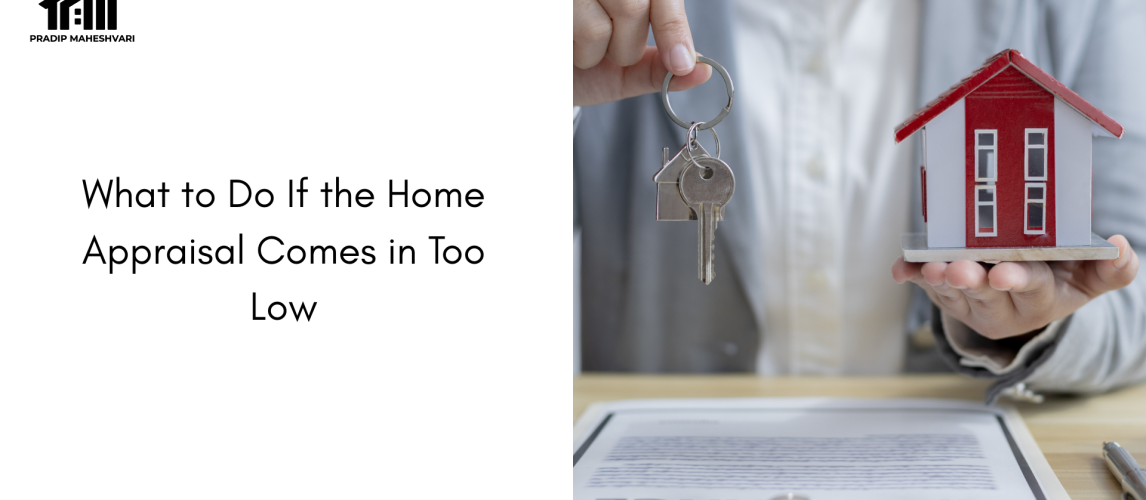You’ve found the perfect home, negotiated the price, and secured a conditional offer, but then the appraisal comes in lower than expected. For many Canadian buyers, this can feel like a deal-breaker. Fortunately, there are several ways to handle a low appraisal without losing your dream home.
Understanding why appraisals come in low and knowing your financing options can help you negotiate effectively, secure lender approval, and stay on track with your home purchase.
In Canada, appraisals are critical because lenders use them to evaluate mortgage risk, CMHC mortgage rules influence approval if valuations drop, and market fluctuations can directly affect property values. That’s why knowing what to do if the home appraisal comes in too low is essential.
Why Do Home Appraisals Come In Low?
Before looking at solutions, it’s important to understand why an appraisal may fall short of the agreed purchase price.
- Market Volatility: Rapid shifts in the Canadian housing market can cause gaps between offer prices and appraised values.
- Outdated or Limited Comparables: If recent sales data isn’t available, appraisers may rely on outdated comps.
- Property Condition Issues: Structural damage or outdated systems can reduce valuation.
- Appraiser Knowledge Gaps: Limited local expertise can result in undervaluation.
What to Do If the Home Appraisal Comes in Too Low
Here are practical strategies to manage a low appraisal and keep your home purchase on track.
1. Review the Appraisal Report Thoroughly
Begin by reading the appraisal report carefully to confirm the information is accurate. Many reports contain small errors that can affect valuation, such as missing upgrades or incorrect square footage. Understanding what influenced the appraiser’s decision will help you plan your next steps.
- Check for missed upgrades or incorrect property details.
- Compare the appraiser’s comps with recent local sales.
- Request clarification from your lender on inconsistencies.
Key Questions to Ask Your Lender
- Were the comps relevant and recent?
- Did the report factor in renovations or upgrades?
- How does the lender interpret the appraiser’s findings?
2. Request an Appraisal Reconsideration
If the report contains errors or uses outdated data, you can request a formal appraisal reconsideration. Provide evidence such as recent sales data or documentation of upgrades to strengthen your case and potentially increase the valuation.
- Submit additional comparable sales data.
- Provide contractor invoices for recent improvements.
- Request a second opinion if major errors exist.
Tips for a Strong Reconsideration Request
- Include at least three newer or more relevant comps.
- Highlight upgrades that increase property value.
- Work with your real estate agent for supporting evidence.
3. Negotiate with the Seller
A low appraisal can work to your advantage when negotiating. If the appraised value is lower than the purchase price, use it as leverage to adjust the terms.
- Ask the seller to reduce the purchase price.
- Propose splitting the valuation gap between both parties.
- Request credits for closing costs to offset the difference.
When Sellers Are More Likely to Compromise
- If the home has been on the market for a long time.
- When there are no competing offers.
- If the seller wants a quick closing.
4. Increase Your Down Payment
If negotiation doesn’t work, consider increasing your down payment to cover the gap between the loan amount and appraised value. This may also help avoid additional costs tied to mortgage insurance.
- Cover the shortfall to secure financing approval.
- Avoid additional mortgage insurance penalties if possible.
- Confirm if CMHC-backed loans allow added flexibility.
5. Explore Alternative Financing Options
If your lender won’t adjust their terms, look into other financing possibilities. Alternative lenders or renovation loan programs can provide flexibility when conventional financing becomes difficult.
- Consider private lenders for short-term financing.
- Look into renovation loans for property upgrades.
- Adjust your pre-approval to reflect the updated valuation.
6. Walk Away If Necessary
Sometimes the most financially responsible decision is to step back from the deal. Protecting yourself from overpaying in an unstable market can save you significant stress and money.
- Protect yourself by including financing conditions in your offer.
- Avoid overpaying in an unstable market.
- Revisit other property options without rushing.
Tips to Avoid Low Appraisal Issues in the Future
While you can’t control market conditions, you can take steps to reduce risks:
- Get a comparative market analysis (CMA) before making an offer.
- Include financing and appraisal clauses in your contract.
- Work with experienced real estate and mortgage professionals.
- Choose lenders with strong ties to local appraisers.
Conclusion
Knowing what to do if the home appraisal comes in too low can help you protect your investment and stay on track toward homeownership. Reviewing the report, requesting reconsideration, negotiating pricing, increasing your down payment, exploring financing alternatives, or even walking away are all viable options.
Facing a low home appraisal? Pradip Maheshvari can help you navigate mortgage solutions, negotiate with lenders, and secure the best financing options to move forward with confidence.


No comment yet, add your voice below!